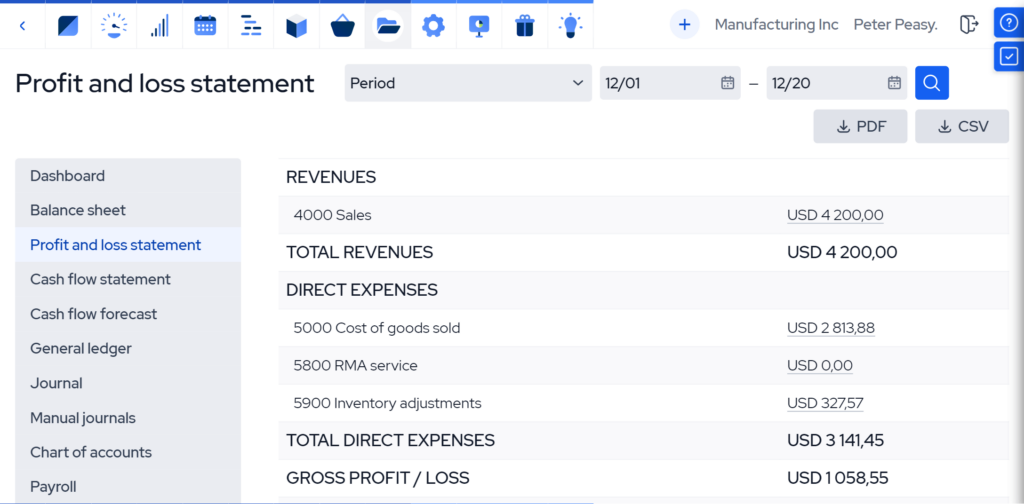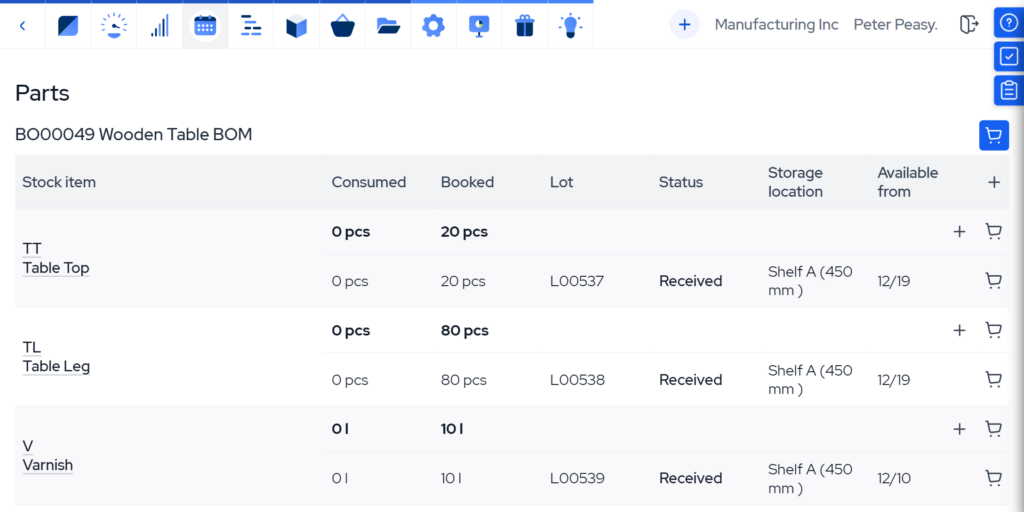Periodic Inventory System vs. Perpetual Inventory System
Managing inventory well is essential for maintaining accuracy and efficiency in your operations. In this guide, we explain periodic and perpetual inventory systems and help you decide which system best suits your business needs.

What is a periodic inventory system?
A periodic inventory system is an inventory valuation practice in which a company’s stock is physically counted over a set period of time. A periodic inventory system depends on manual counts to value inventory and know whether inventory records are accurate. These counts are the only way to reconcile inventory with accounting and accurately calculate financial metrics like the cost of goods sold and ending inventory.
Because it only updates records at the end of each accounting period, a periodic inventory method is useful for businesses that do not need real-time inventory monitoring but still need accurate financial reporting. Small businesses using this system often conduct weekly counts to spot irregularities or cycle counts to ensure important items’ stock levels.
Periodic inventory systems are still widely used today, usually by smaller companies with limited inventories and low trade volumes. They are often used within spreadsheets, simple standalone inventory software, or paper-based inventory management systems.
What is a perpetual inventory system?
A perpetual inventory system is an inventory valuation practice that continuously records all changes to inventory levels, keeping the inventory records accurate at all times. Perpetual inventory systems also continuously calculate the cost of goods sold account, increasing financial reporting accuracy.
Perpetual inventory systems rely on inventory management software that records changes to inventory levels using inputs from POS systems (point-of-sale), barcode systems used in the warehouse, and shop floor reporting. When raw material gets consumed in a manufacturing order, for example, a perpetual inventory system automatically updates the material’s stock level, negating the possibility of double-booking the item.
Since a perpetual inventory system continuously keeps stock records corresponding to real inventory levels, it’s superior to periodic systems in terms of inventory control, accounting accuracy, and production tracking.
Periodic vs. perpetual inventory accounting
The key difference between periodic and perpetual systems lies in how and when they update inventory records and calculate financial metrics like the cost of goods sold (COGS), beginning and ending inventory, and purchases. This significantly affects the accuracy of financial statements throughout an accounting period.
Let’s examine the differences between these systems in inventory accounting regarding COGS, beginning and ending inventories, and purchases.
Accounting for cost of goods sold (COGS)
In a periodic inventory system, COGS is calculated at the end of the accounting period using these formulas:
For items that you resell:
COGS (resold items) = Beginning inventory + Purchases – Ending inventory
For items that you manufacture, purchases are swapped with the cost of goods manufactured:
COGS (manufactured items) = Beginning inventory + Cost of goods manufactured (COGM) – Ending inventory
Since a physical inventory count is required to determine the ending inventory, COGS is only updated at the end of an accounting period. The lack of real-time tracking can result in discrepancies during production, which can lead to unexpected adjustments when the physical count is conducted.
In a perpetual inventory system, COGS is calculated continuously as sales occur. Every time an inventory item is sold, the system updates COGS based on the item’s cost. This allows for accurate real-time financial reporting and largely eliminates the need for a physical count to reconcile COGS.
Accounting for beginning and ending inventory
Beginning and ending inventories are determined only through physical counts in periodic counting, usually at the start and end of the accounting period. Beginning inventory is the leftover stock from the previous period, while ending inventory is what’s left after all sales, manufacturing, and purchases for the current period.
In perpetual Inventory systems, on the other hand, the ending inventory value is arrived at automatically as purchases, manufacturing, and sales occur. The system continuously tracks inventory data and movements, and every transaction—whether it be a sale, manufacture, or purchase—triggers automatic journal entries, ensuring that inventory records are always up to date.
Accounting for purchases
In periodic systems, inventory purchases are recorded as a separate line item in the accounting records and added to the beginning inventory at the end of the period. Purchases do not directly affect the inventory or COGS during the period. Instead, they are only reconciled once the accounting period ends.
Perpetual inventory systems reflect procurement continuously in the general ledger, automatically adjusting stock levels. This real-time tracking eliminates the need to wait until the end of the period to know the accurate amount of inventory as it becomes available.

Differences in inventory valuation
Inventory valuation methods like FIFO (First In, First Out), LIFO (Last In, First Out), and weighted average also differ in their application when used in periodic or perpetual inventory systems. These methods determine how inventory costs are assigned to COGS and ending inventory.
Let’s look at each in a bit more depth.
FIFO (First In, First Out)
FIFO valuation assumes that the oldest inventory items are sold first. However, since inventory is only updated at the end of the accounting period, there is no real-time accounting insight into whether older stock has been sold, meaning COGS is not accurately tracked until the period closes. The ending inventory is based on the most recently purchased or produced goods after completing the count.
In a perpetual system, FIFO is applied continuously. The system records each transaction in real-time, ensuring that the oldest inventory is sold first. This means that COGS is updated immediately after each sale and ending inventory always reflects the most recent purchases. This consistent tracking provides accurate financial information throughout the accounting period.
LIFO (Last In, First Out)
Under periodic LIFO, the most recently purchased inventory is considered sold first, but this assumption is only applied at the end of the accounting period. Similar to FIFO, no adjustments are made during the period itself. COGS is calculated based on the most recent purchases at the time of the physical count, and the ending inventory consists of the older, less recent inventory.
In a perpetual system, LIFO, too, is applied continuously, meaning that each time inventory is sold, the most recent purchases are used to calculate COGS. This provides more up-to-date and accurate financial reporting because COGS reflects current inventory costs. Ending inventory, therefore, contains the older, lower-cost items, and these values are adjusted in real-time as transactions occur.
Weighted average
In a periodic system, the weighted average cost is calculated at the end of the accounting period by dividing the total cost of goods available for sale by the total number of units available. This average cost is then used to calculate COGS and ending inventory at the close of the period. The weighted average method provides a smooth, blended cost for inventory but only applies the average at the end of the period, meaning the financial data is less precise during the period.
With the perpetual inventory method, the weighted average cost is recalculated after each new purchase order. This ensures that the COGS and ending inventory reflect the most up-to-date average cost of inventory throughout the accounting period. Each time new inventory is acquired, the system updates the average cost and adjusts financial data accordingly. This method allows for a more accurate and dynamic representation of inventory costs in real time.
The benefits of perpetual inventory systems
As we have seen, perpetual inventory systems far outperform periodic ones in most facets of inventory management. The only tangible benefit of a periodic inventory system over a perpetual one is the simplicity of managing inventory, as it doesn’t require implementing inventory software or making every inventory item digitally trackable.
However, simplicity comes with limitations to record-keeping, traceability, and accessibility. Periodic systems limit the availability of information for decision-making, incur time-consuming extra counts every time a stock level needs to be checked, and may incur potential inaccuracies from human errors in manual counting. Therefore, periodic systems are a cost-effective solution only for smaller businesses that don’t need to track inventory continuously.
On the other hand, here are the core benefits of perpetual inventory systems:
- Stock traceability. Perpetual inventory systems enable businesses to get real-time data updates on all stock movements at every stage in the production pipeline. Constant tracking allows for enhanced visibility and control over the flow of goods, reducing instances of misplaced or unaccounted-for items. By improving traceability, perpetual systems also simplify regulatory audits and compliance with industry standards.
- Accurate inventory balances. Perpetual systems maintain precise, always up-to-date inventory balances, eliminating the guesswork involved in stock management. Every purchase, sale, and production movement is recorded instantly, providing real insight into inventory availability at any given moment. This enables better planning, prevents stockouts or overstocking, and enhances financial reporting by aligning records with actual inventory levels.
- Integrated production and supply chain management. By continuously updating inventory records, perpetual systems enable tighter integration between production, warehousing, and supply chain management. Real-time coordination enhances workflows and simplifies production planning, ensuring that materials and products are available exactly when needed. The result is reduced lead times, improved responsiveness to changes in demand, and overall increased operational efficiency.
- Time savings. While most manufacturers still conduct a full inventory count at the end of accounting periods to verify accuracy, perpetual systems save considerable time by eliminating the need for frequent manual counts. Automatically tracking stock levels also reduces time-consuming inventory errors and minimizes manual data entry, helping teams focus on higher-value tasks.

Which inventory system should I choose?
Choosing between a perpetual vs periodic inventory system depends mainly on the size of your business, the complexity of your inventory, and your requirements for stock visibility. Also, if your company plans to grow, bear in mind that periodic inventory systems quickly reach their limits when inventory and supply chain complexity start to expand.
Even if you have simple stock and it’s likely to stay that way, modern inventory software has matured a lot in the past years. Many providers offer easy-to-use, fully cloud-based solutions that significantly enhance your inventory management and tracking at very affordable prices. Implementing an automated inventory management system is much easier when the company is still relatively small, reducing the need for complex change management later.
Although initial setup and training require investment, modern inventory and production software provides compounding long-term value. For instance, MRPeasy offers an affordable and user-friendly platform to simplify tracking and stock control, while advanced features can be unlocked as your business grows.
Check out our success stories to learn more about how MRPeasy can work for you.
Key takeaways
- A periodic inventory system is an inventory management method where stock is physically counted at the end of each period, updating inventory records periodically rather than continuously.
- A perpetual inventory system is an inventory management method that utilizes automated software to track inventory changes and update records in real time as items are bought, manufactured, sold, or used.
- In periodic inventory, inventory accounting is conducted only at the end of each period, making it best suited for smaller businesses with simple inventory needs. Perpetual inventory systems keep inventory records accurate in real-time, providing continuous updates to the cost of goods sold and purchase accounts.
- Perpetual inventory systems offer many benefits over periodic systems, like improved stock traceability, real-time data accuracy, and streamlined production and supply chain integration.
- Choosing between a perpetual and periodic system comes down to business size, inventory complexity, and a company’s ambitions for growth.
Frequently asked questions
Periodic inventory updates inventory records only at the end of each accounting period, typically after a physical count. On the other hand, perpetual inventory continuously tracks changes in stock levels, updating inventory records in real-time with each transaction.
FIFO (First In, First Out) can be used with both periodic and perpetual inventory systems. In a periodic system, FIFO is applied at the end of the period, while in a perpetual system, FIFO is applied with each transaction in real time. FIFO’s effect on the cost of goods sold and ending inventory account remains unchanged regardless of whether perpetual or periodic inventory is used.
Most larger companies and those with complex inventory requirements use perpetual inventory systems due to the benefits of real-time tracking and data accuracy. Smaller companies with simpler stock may opt for periodic systems as they require less technology and oversight.
You may also like: Batch Tracking – A Simple Guide



